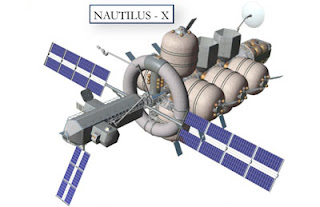Mars Direct vs FY11 NASA Direction
This morning Bob Zubrin will be arguing the case for Mars Direct over the NASA future direction. This is what I'd really like to be able to talk to him about but probably won't get a chance to. [About an hour after I wrote this post a friend of mine decided it would be hilarious to introduce me to Bob Zubrin and then run away. I started the conversation by saying that I thought he had too many strong, stupid and offensive opinions, but rather than punch me in the face or walk away he suggested we discuss our differences. And so we did.. for about 2 hours. He agreed with many of these points but insisted that new NASA administration won't actually be doing any of the stuff they say they will.. we'll see.]
There's a lot of common ground between the two plans but all the focus is, of course, on the differences. Dr Zubrin can't be happy that NASA is doing work that supports his plan, only being appointed the Space Czar will do.
Common Ground
But today's session will probably focus on commercial crew and asteroid missions.. in other, words, irrelevant politics.
There's a lot of common ground between the two plans but all the focus is, of course, on the differences. Dr Zubrin can't be happy that NASA is doing work that supports his plan, only being appointed the Space Czar will do.
Common Ground
- "Mars as destination" - Mars is the declared destination of both programs. That's a big deal, there's lots of other places that could be the destination. Considering that NASA has long been banned from considering Mars the destination, that's something worth celebrating.
- Nuclear Power qualified for use in space - Both plans make critical use of fission nuclear power.
- Entry, Descent and Landing in the Mars atmosphere - Landing on Mars is hard and precision landing of large payloads (double digit tons) is required for any human Mars program.
- In-situ utilization of the Mars atmosphere for a preplaced ascent stage - This is a Zubrin original idea that has been whole-heartedly adopted by NASA.
- Long stays for conjunction - Zubin famously made the case for staying on the Mars surface for long stays to reduce the duration of transit to months instead of years, again adopted by NASA as a standard.
But there are differences and, although they shouldn't be focused on they should be acknowledged.
Disagreement- Mission mode - obviously, Mars Direct is a direct mode, whereas the new plan (and most other Mars plans) leaves from LEO. The future NASA plans also call for aerobraking into Mars orbit.
- Zero-g mitigation - Mars Direct famously proposed the use of a tethered spinning habitat, a risky proposition. Whereas the future NASA plan is what I call Charlie Bolden's Magic Rocket - reducing the transit time so zero-g isn't a major issue.
- Radiation mitigation - the reduction in transit time also helps here. The Mars Direct plan has always been a combination of crew selection (all smokers, make em quit, ha ha), shielding with supplies (there's not enough and as you eat them..) and just outright denial.
But today's session will probably focus on commercial crew and asteroid missions.. in other, words, irrelevant politics.


Radiation is the big one IMHO especially GCRs and the sort of shielding to stop those would be enormous. Easier to use a amall asteroid (Deimos) as an Aldrin cycler.
ReplyDeleteI am not a fan of Mars Landings:
- as failed exo-biologist the last thing I want to see is dirty humans mucking up the results
- landings cost too much
Phobos First. (Mars is just another Well!)
Back up a moment Skippy. Show me where Bolden's plan is making use of nuclear power ... either NEP or NTP ... And more importantly, show me the money that is going into research for one of these. The VASIMR ain't squat without a nuclear power source.
ReplyDeleteThat is one of Zubrin's, and my, complaints. There's no plan for one.
Space nuclear reactors is in the laundry list of tech to be developed and has some money under the FTDP. NEP is listed on the advanced propulsion roadmap for the 2020 timeframe.
ReplyDeleteNTP was in some documents but I haven't heard much since. It's an infrastructure rebuilding exercise and without DOE help that could be hard.
I'm sure that there are a lot of things on the "laundry list" but that doesn't mean squat until a project is announced and funded.
ReplyDeleteIMO, NTP is the better way to go. We have extensive knowledge from the NERVA program. NTP is less complex than NEP. That should mean a much short development timeframe. My guess ... and it's only a guess ... is that developing the nuclear power plant (NPP) for NEP will take around ten years (NTP would be about half that). So if you want to use it in 2020, you need to get it started now.